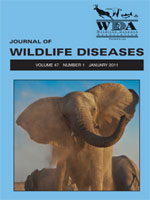The stomachs and proximal duodena of 160 cougars (Puma concolor) and 17 bobcats (Lynx rufus), obtained throughout Oregon during 7 yr, were examined for Cylicospirura spp. and associated lesions. Prevalence in cougars was 73%, with a range in intensity of 1–562 worms. The mean diameter of nodules was 1.2 cm (SD=0.5), and many extended through the submucosa to the muscularis. About 83% of cougars had nodules; most nodules contained worms, but 14% of the smaller nodules (<0.2 cm) contained porcupine (Erethizon dorsatum) quills. A mean of 12.4 worms/nodule (SD=34.1) was observed, with a maximum of 340 worms/nodule. Prevalence in bobcats was 53%, with an intensity of 1–25 worms. About 65% of bobcats had nodules, which were slightly smaller than those in cougars but appeared to involve similar layers of gastrointestinal tissue. One to 25 Cylicospirura sp. were found in all but two small nodules in bobcats. Cougars killed for livestock damage or safety concerns had a significantly higher median worm intensity than did those that died of other causes. Also, the median worm intensity of older cougars was higher than that of younger lions. There were more males than females killed for livestock damage or safety concerns. The cylicospirurid from cougars was Cylicospirura subaequalis, and that of bobcats was Cylicospirura felineus. These two similar species were separated morphologically by differences in tooth and sex organ morphology. They were also differentiated by DNA sequence analysis of the mitochondrial cytochrome c oxidase subunit 1 gene (cox1). Worm sequences from cougars differed from those from bobcats by 11%, whereas essentially no difference was found among worms from the same host. Phylogenetic analysis showed that within the order Spirurida, both cylicospirurids were most closely related to Spirocerca lupi, based on this gene sequence.
How to translate text using browser tools
1 January 2011
CYLICOSPIRURA SPECIES (NEMATODA: SPIROCERCIDAE) AND STOMACH NODULES IN COUGARS (PUMA CONCOLOR) AND BOBCATS (LYNX RUFUS) IN OREGON
Jayde A. Ferguson,
Karen Woodberry,
Colin M. Gillin,
DeWaine H. Jackson,
Justin L. Sanders,
Whitney Madigan,
Robert J. Bildfell,
Michael L. Kent
ACCESS THE FULL ARTICLE

Journal of Wildlife Diseases
Vol. 47 • No. 1
January 2011
Vol. 47 • No. 1
January 2011
bobcat
cougar
Cylicospirura spp.
livestock damage
mtDNA sequence
phylogenetic analysis
spirurid nematodes




